
Backbone Trail Training 2014 – Stunt to Kanan


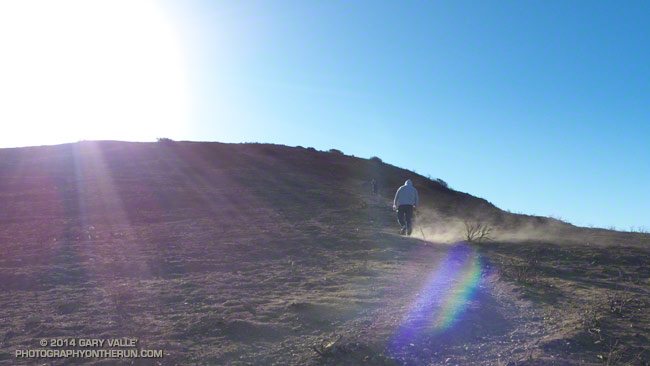
Offshore wind events have been frequent this rain season. They often follow “inside slider” systems that miss Southern California and take a more inland track over the West. The result is more wind and less rain.
Los Angeles wrapped up calendar year 2013 with the least amount of rainfall on record. When talking about rainfall in Southern California it is more common to refer to the “rain year” which runs from July 1 to June 30. (The water year was changed to October 1 to September 30,)
So when was the driest rain year in Los Angeles? It was just a few years ago, in 2006-2007 when only 3.21 inches of rain was recorded. It was also driest water year on record with only 3.73 inches of rain.
There were also many wind events in that dry rain season, and like this January not a lot of green in the hills. To date we have had less rainfall this water year than in 2006-2007!
For the most part this Fall and Winter I’ve been able to work around the wind events and do runs that more or less escaped the wind. I thought that was going to be the case again today. The predicted offshore event seemed to be behind schedule and when I left for the Wendy Drive trailhead there wasn’t much wind.
There were stirrings of an offshore breeze at the trailhead and I commented to a hiker that I hoped the winds would hold off until later in the day. The plan was to do the out and back run from Wendy Drive to Mugu Peak. Because of the myriad of route choices, this is a fun run to do as a time challenge. What is the fastest route? Try it and see.
Things looked good all the way down Sycamore Canyon and into La Jolla Valley, but the wind started to pick up as I worked toward Mugu Peak.
Once on the peak it was like flipping a switch on a wind tunnel! I was ahead of my PR to the peak by several minutes and I was trying to push the pace. That was not happening and several times I had to pause and put a hand down as I staggered in the middle of a big step.
I caught up to a couple of people just before the final steep push to the summit. The wind flow was not as turbulent and gusty here and one of them started to run. With each stride the dust streaked from his shoes. I stopped to take some photos and this short video clip. The smoother winds didn’t last for long, and neither did the running.
Mugu Peak’s next door neighbor to the west, Laguna Peak, has recorded a wind gust of 125 mph. In this photo from Boney Mountain Mugu Peak is on the far left and Laguna Peak has the communications equipment on the summit. Today I’d estimate the strongest gusts on Mugu Peak were in the range of 50-60 mph. The winds were strong enough that the sewn end of a fluttering strap was like a whip and just as capable of raising a welt.
I spent zero time on the summit and was very happy to get back down to La Jolla Valley.
Some related posts: Wendy Drive – Mugu Peak Challenge, La Jolla Valley & Mugu Peak from Wendy Drive
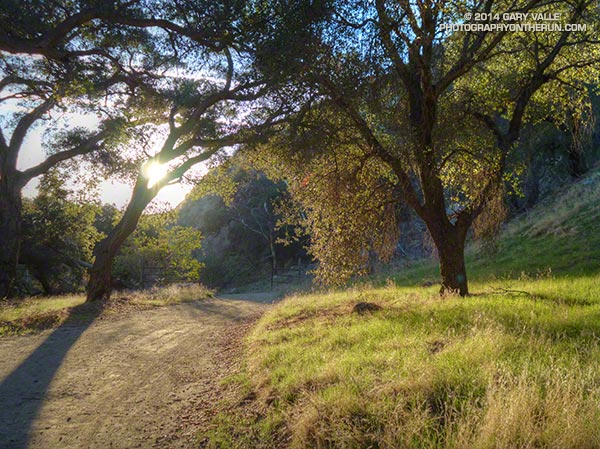
Not everywhere is parched and brown in moisture-starved Southern California. There are a few places that have slurped up a few extra raindrops and are turning green.
This patch of green is in Las Llajas Canyon, in the eastern Simi Valley. Judging from the green growth and dried mud on the road in the upper part of the canyon, there must have been some extra rainfall here. There was even some water in one section of the creek.
Las Llajas Canyon is part of the 50K & 30K courses in the Bandit Trail Runs coming up February 16, 2014 at Corriganville Park in Simi Valley, CA.
Note: The Bandit Trail Runs event is now Rocky Peak Trails.
Some related posts: Bandit 50K 2013 Notes, Las Llajas Longhorns, Chumash-Las Llajas Loop
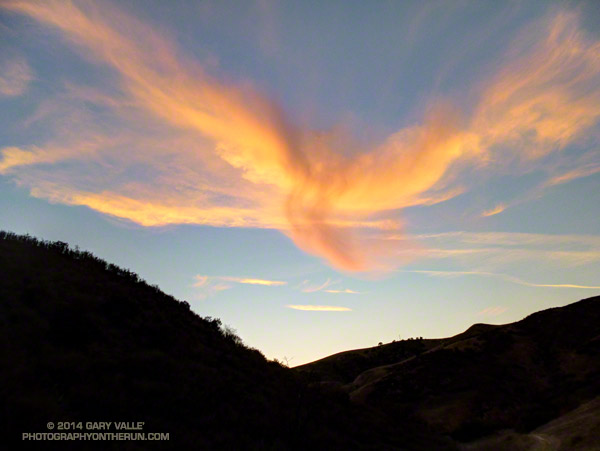
With some long runs looming in the not too distant future it seems many of my runs are ending after dark — even on New Year’s Eve.
There’s an extra measure of involvement when the sun is setting and it’s an hour back to the trailhead. Yes, it’s easy to carry a headlamp, but it’s more fun to try and get along without it. Without the headlamp you become part of your surroundings, with it you’re just a visitor.
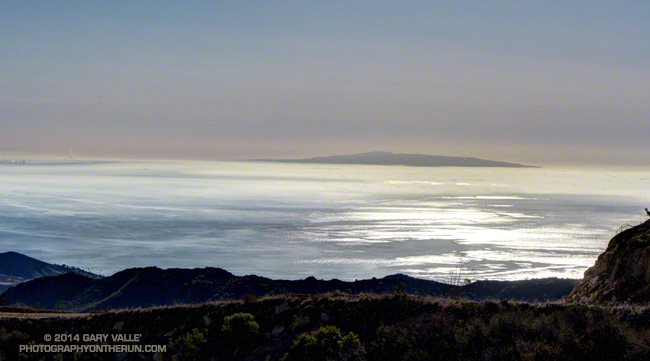
The tinge of frost on the rusty M*A*S*H ambulance wasn’t so much of a surprise, but that there was not even a breath of wind at the M*A*S*H site was astonishing.
Overnight unrelenting winds had rushed and roared through the palm trees above the house and I’d steeled myself for what would surely be a difficult run.
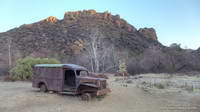
But when I arrived at the Cistern trailhead on Mulholland Drive there was almost no wind. A layer of cold air trapped against the crest of the Santa Monica Mountains in the Malibu Creek drainage was shielding the area from the wind. At least for a while.
When I’d left the house in the West Valley the temperature had been a balmy 64 degrees. As I turned onto Mulholland Highway from Malibu Canyon Road my car’s thermometer had read 32 degrees and at the trailhead it had been 46 degrees. Along Malibu Creek at the M*A*S*H site I’d guess the temperature was in the mid-thirties.
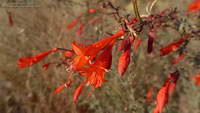
Incredibly, the climb up Bulldog Motorway was one of the most pleasant I’ve done. Near freezing temperatures gave way to warming Winter sunshine, and as I worked up the grade I wondered how long the respite from the wind would last. To the northeast I could see the telltale dusty haze from strong offshore winds in the San Fernando Valley. At some point those winds would scour out the protective layer of cold air or I would climb above it.
It wasn’t until about halfway up the Bulldog climb that the wind started to pick up. But it was still far less windy than I had expected. Several sections of Castro Peak and Mesa Peak fire roads were in the lee of the crest, and the running was excellent. The variegated patterns of sun, stratus and wind on the Pacific was spectacular.
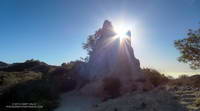
Once I was off the crest the wind diminished to little more than a zephyr. In many areas — such as at Tapia Park and along Crags Road there was no wind at all.
But it was still windy in the West Valley. When I got home from the run I checked the Cheeseboro RAWS, which is about 6 miles NNE of Malibu Creek State Park. Between 9:30 and 10:30, when it had been dead still on Crags Road, the Cheeseboro RAWS had recorded steady winds of 30 mph, gusting to as high as 50 mph!
The title photo is of windblown stratus on Santa Monica Bay with Palos Verdes Peninsula in the distance.
Some related posts: Malibu Creek State Park Scenic Loop, Vertical Relief
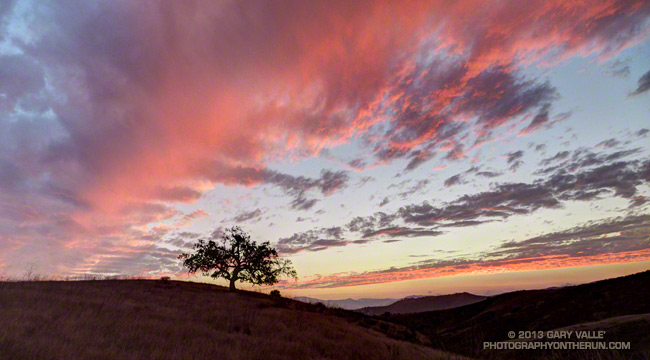
Long colors spread across the sky, flamboyant and vivid, fading with time.
Gravity is suspended and the world glides effortlessly by.
In growing darkness warm hillsides cling to the day and cold canyons foretell the night.
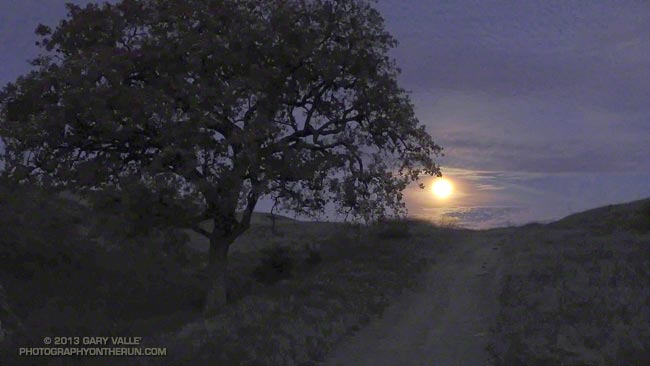
Running is more by feel than by sight.
A full December moon rises, eerie in the clouds. Coyotes yip, yip, yip on a nearby hill.
An owl waits, and then fills the silence with a hoot, hoot, hooo…
I switch on my headlamp and it all disappears.